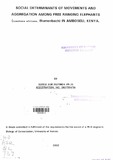| dc.description.abstract | It is now widely accepted that elephant female groups live in complex social units,
family that are led by a matriarchs, who is the oldest female in the group. It is also
established that the matriarch, through complex acoustic and probably, olfactory
signalling, exert tremendous influence over the group on where to go, when to leave a
habitat patch, and when to attack during group defence and what species of animal to
attack and in what set of circumstances. It is also reported that matriarchs play a
leadership role in movements of female groups to distant habitats along certain used
routes. If the behaviour by the oldest female is to make any sense, it needs to be
viewed in evolutionary terms. Family groups are constituted of closely related
individuals and by living and moving as a group, females are likely to increase their
fitness value compared to if they were to live and move singly or with their young
calves. However, group living creates a challenging environment to elephants because
of their enormous forage (average, 170kg fresh plant mass/day/adult animal) and water
(on average, 150Its/day/adult animal) requirements and increased competition for these
resource as group size increase. Despite these challenges, large aggregations, some
containing as many as 500 individuals are common in savannah subs-species of the
African elephant (Loxodonta africana africana) during the wet season. It is clear
that family units prefer to assemble and form large aggregation when conditions are
favourable following onset of rains, and c;!)sband into individual units or sections of
family units when conditions are severe such-as during dry season or droughts | en |

